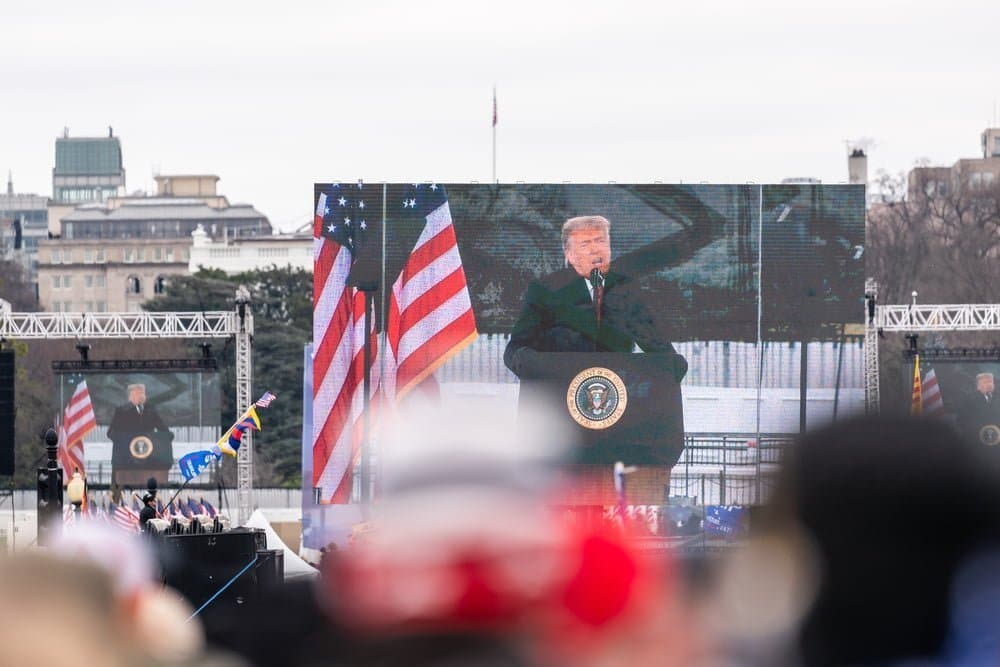New York Times publisher A.G. Sulzberger has issued a lengthy warning in the Washington Post (9/5/24) on the dangers another Donald Trump presidency would pose to a “free and independent press.”
Sulzberger details Trump’s many efforts to suppress and undermine critical media outlets during his previous presidential tenure, as well as the more recent open declarations by Trump and his allies of their plans to continue to “come after” the press, “whether it’s criminally or civilly.” He documents the ways independent media have been eroded in illiberal democracies around the world, and draws direct links to Trump’s playbook.
You might expect this to be a prelude to an announcement that the New York Times would work tirelessly to defend democracy. Instead, Sulzberger heartily defends his own miserably inadequate strategy of “neutrality”—which, in practice, is both-sidesing—making plain his greater concern for the survival of his own newspaper than the survival of US democracy.
‘Wading into politics‘
“As someone who strongly believes in the foundational importance of journalistic independence,” Sulzberger writes, “I have no interest in wading into politics.”
It’s a bizarre statement. Newspapers, including the Times, regularly endorse candidates. Presumably, then, he’s referring to the “news” side of the paper, rather than the opinion side.
But, even so, you can’t report on politics without wading directly into them. Which political figures and issues do you cover, and how much? (See, for example: media’s outsize coverage of Trump since 2015; media’s heavy coverage of inflation but not wage growth.) Which popular political ideas do you take seriously, and which do you dismiss as marginal? (See, for example, the Times‘ persistent dismissal of Bernie Sanders’ highly popular critiques.) These decisions shape political possibilities and set political agendas, as much as the Times would like to pretend they don’t (FAIR.org, 5/15/24).
Sulzberger goes on (emphasis added):
“I disagree with those who have suggested that the risk Trump poses to the free press is so high that news organizations such as mine should cast aside neutrality and directly oppose his reelection.”
READ: Trump Shares Social Media Posts with QAnon Phrases and Calls for Jailing Lawmakers, Special Counsel
Sulzberger is always raging against critics who, he claims, want him to skew and censor his paper’s reporting (FAIR.org, 5/19/23). The Times must instead be steadfastly “neutral,” he claims. But those very political coverage decisions that media outlets make on a daily basis make it impossible for the outlets to be neutral in the way Sulzberger imagines.
Neutrality could mean, as he suggests, independent or free from the influence of the powerful in our society. This is possible—if difficult—for media outlets to achieve. Yet the Times, like all corporate media, doesn’t even try to do this.
Instead, the Times seems to take neutrality as not appearing to take sides, which in practice means finding similar faults among both parties, or not appearing overly critical of one party or the other (FAIR.org, 1/26/24). This strategy didn’t work particularly well when Republicans and Democrats played by the same set of rules, as both parties took the same anti-equality, pro-oligarchy positions on many issues.
But it’s particularly ill-suited to the current moment, when Republicans have discarded any notion that facts, truth or democracy have any meaning. If one team ceases to play by any rules, should the ref continue to try to call roughly similar numbers of violations on each side in order to appear unbiased? It would obviously be absurd and unfair. But that’s Sulzberger’s notion of “neutrality.”
It would be brave for a media outlet like the Times to take a stand and oppose Trump’s candidacy. But it would make a big difference if the paper would even do the bare minimum of calling fouls fairly rather than evenly.
‘A fair and accurate picture‘
“It is beyond shortsighted to give up journalistic independence out of fear that it might later be taken away,” Sulzberger continues. “At the Times, we are committed to following the facts and presenting a full, fair and accurate picture of November’s election and the candidates and issues shaping it.”
A “full, fair and accurate picture” of the election and its stakes are exactly what the Times‘ critics are asking for. Instead, the Times offers a topsy-turvy world in which crime is still a top concern (it’s at its lowest level since the 1960s—FAIR.org, 7/25/24)); inflation has been brought down to near the Fed’s ideal rate of 2%, but it’s still “a problem for Harris” (7/23/24); the nation’s “commitment to the peaceful resolution of political difference” is primarily threatened by neither party in particular (FAIR.org, 7/16/24); and Biden’s age merits more headlines as a danger to the country than Trump’s increasing incoherence–or his refusal to commit to accepting the results of the election.
It’s not “giving up independence” for a news outlet to try, through its reporting, to prevent a tyrant from taking over the country. There’s no reason the paper can’t put the threats posed by Trump on its front page every day while continuing to offer careful scrutiny of the Harris campaign. But it’s also worth asking: What good is a “free” press if it can’t protect democracy before it’s gone?
‘Balance’ at all costs
Sulzberger concludes by explaining how he plans to confront the looming challenge Trump presents—by preparing for lawsuits and harassment and, most crucially, by not taking sides:
“Through it all, treating the journalistic imperative to promote truth and understanding as a north star — while refusing to be baited into opposing or championing any particular side. ‘No matter how well-intentioned,’ Joel Simon, the former head of the Committee to Protect Journalists, wrote last month on what he’s learned studying attacks on press freedom, ‘such undertakings can often help populist and authoritarian leaders rally their own supporters against ‘entrenched elites’ and justify a subsequent crackdown on the media.’”
READ: Common Cause Addresses Emerging and Evolving Threats to Upcoming 2024 Election
Does Sulzberger actually think that by writing a several-thousand-word warning against Trump’s threat to press freedom, but simultaneously announcing that he will resolutely oppose “taking sides” in this election, he is somehow inoculating himself against right-wing populist hatred of the Times, and any future retribution from a Trump presidency?
The far right has learned how to exploit this central weakness of corporate media, its adherence to “balance” at all costs. Sulzberger might think he’s working to fend off Trump’s attack on an independent press corps; in fact, he’s playing right into Trump’s hands, and working to speed along his own paper’s irrelevance.
ACTION ALERT: You can send a message to the New York Times at letters@nytimes.com. Please remember that respectful communication is the most effective. Feel free to leave a copy of your communication in the comments thread.
This article was originally published at FAIR (Fairness & Accuracy in Reporting). It is reprinted here via Creative Commons 3.0.






